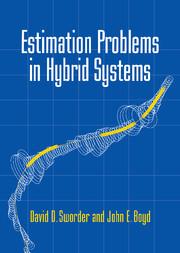Book contents
- Frontmatter
- Contents
- List of Illustrations
- Preface
- 1 Hybrid Estimation
- 2 The Polymorphic Estimator
- 3 Situation Assessment
- 4 Image-Enhanced Target Tracking
- 5 Hybrid Plants with Base-State Discontinuities
- 6 Mode-Dependent Observations
- 7 Control of Hybrid Systems
- 8 Target Recognition and Prediction
- 9 Hybrid Estimation Using Measure Changes
- Appendix 1 PME Derivation Details
- Appendix 2 COM Derivation Details
- Bibliography
- Index
- Glossary
8 - Target Recognition and Prediction
Published online by Cambridge University Press: 17 August 2009
- Frontmatter
- Contents
- List of Illustrations
- Preface
- 1 Hybrid Estimation
- 2 The Polymorphic Estimator
- 3 Situation Assessment
- 4 Image-Enhanced Target Tracking
- 5 Hybrid Plants with Base-State Discontinuities
- 6 Mode-Dependent Observations
- 7 Control of Hybrid Systems
- 8 Target Recognition and Prediction
- 9 Hybrid Estimation Using Measure Changes
- Appendix 1 PME Derivation Details
- Appendix 2 COM Derivation Details
- Bibliography
- Index
- Glossary
Summary
Problem Statement
State estimation and control is made difficult in a hybrid system by the multiplicative nonlinearities in the equation of base-state evolution. The PME fuses complementary data streams using the dual path architecture shown in Figure 4.1 in a finite-dimensional algorithm for approximating the Gt-error moments useful in a broad range of applications.
In earlier chapters we have used the PME to estimate the base-state of a moving platform (called here the target). In these applications, a plausible motion model for the target was known a priori. There are situations in which this important information is lacking, for example in cases where the target must be identified while simultaneously tracking it and predicting its future motion. Identification in this context is called automatic target recognition (ATR). Prediction can take many forms, but we will focus on predicting the location where the target intersects a boundary in state space.
Uncertainties in target identification compound those already present in target location at time of detection and the accretion of disturbances along the path. Model-based path-following algorithms utilize a formal model to represent target evolution, and the selection of a tracking algorithm is based upon the target dynamics as articulated in the model. Because the tracking algorithm is tuned to a particular dynamic class, it is advantageous to know the proper class in advance, or if unknown, to identify it as soon as possible.
- Type
- Chapter
- Information
- Estimation Problems in Hybrid Systems , pp. 171 - 196Publisher: Cambridge University PressPrint publication year: 1999



